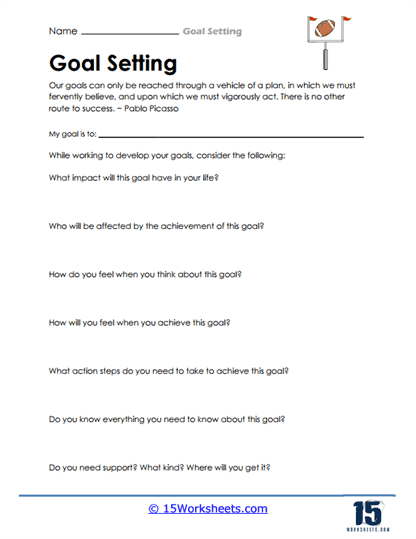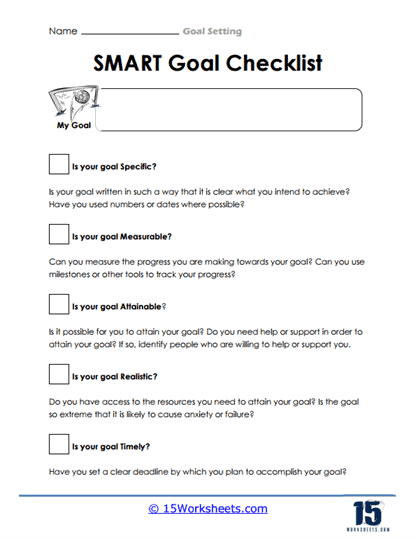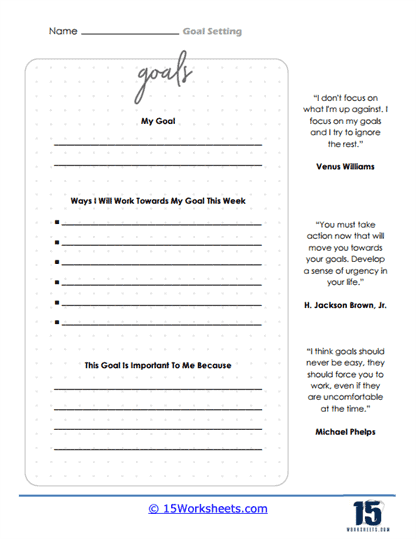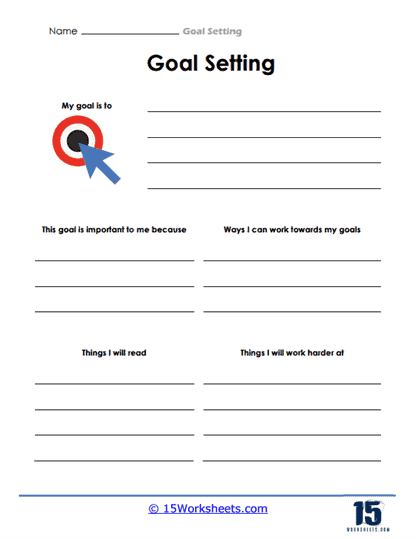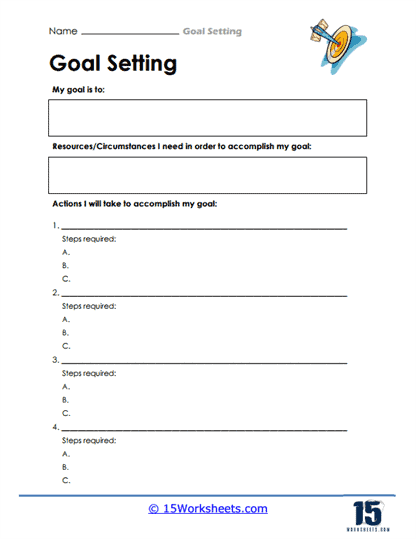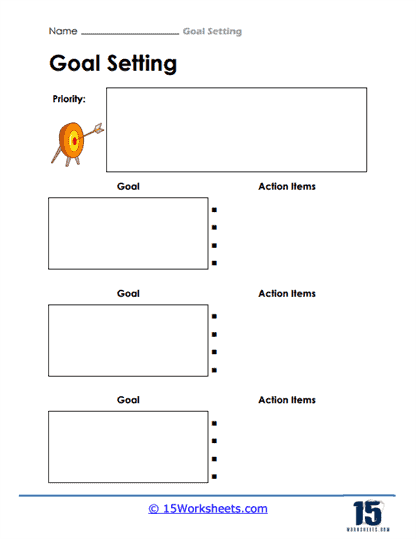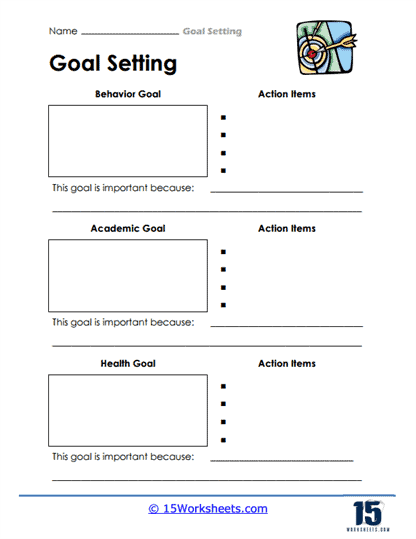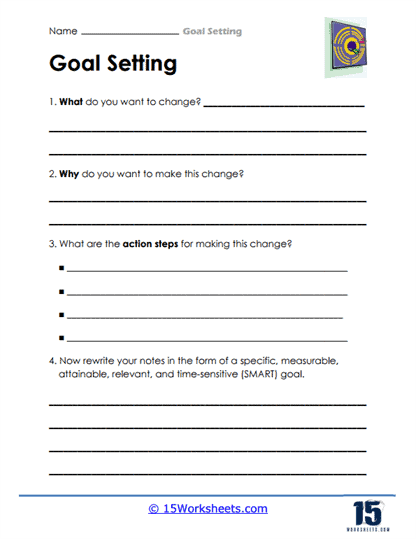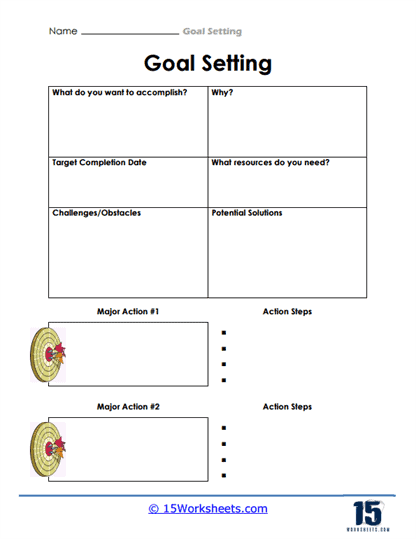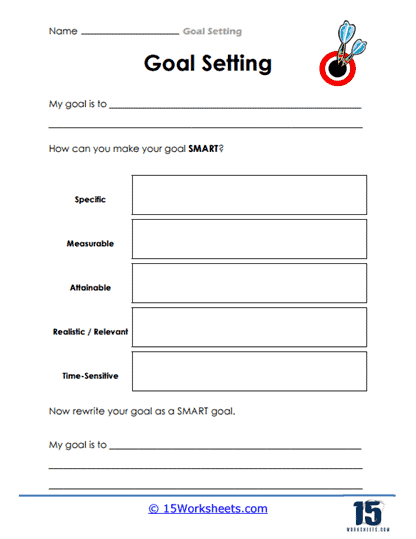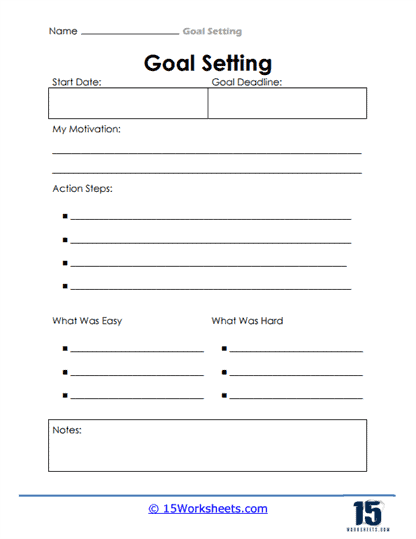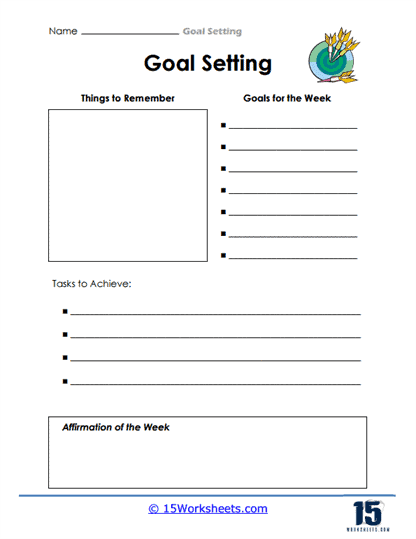Goal Setting Worksheets
About These 15 Worksheets
Each worksheet in this collection is thoughtfully designed to guide students through the process of setting realistic and attainable goals, while also encouraging reflection on their personal motivations, strengths, and the steps necessary to reach their objectives. These worksheets are available in PDF format, making them easy to view, download, and print, providing flexibility for use in various educational settings.
One of the key worksheets in this collection is the SMART Goal Checklist. This worksheet introduces students to the SMART criteria-Specific, Measurable, Attainable, Relevant, and Time-bound-ensuring that the goals they set are clear and actionable. Students are prompted to think critically about what they want to achieve, how they will measure progress, and what resources or support they might need. By breaking down their goals into manageable steps and setting realistic deadlines, students learn the importance of planning and time management. This worksheet is particularly useful for helping students develop a structured approach to goal-setting that can be applied to both academic and personal ambitions.
Another essential worksheet in this collection focuses on Identifying Strengths and Challenges. In this activity, students are encouraged to reflect on their personal strengths that can help them achieve their goals, as well as potential challenges they might face. This self-assessment not only fosters self-awareness but also encourages students to think about strategies for overcoming obstacles. By identifying both internal and external factors that could impact their progress, students are better prepared to tackle their goals with confidence and resilience. This worksheet is an excellent tool for building a growth mindset, as it highlights the importance of perseverance and problem-solving in the face of challenges.
The Action Plan worksheet is another valuable component of this collection. It guides students through the process of outlining specific steps they need to take to achieve their goals. By breaking down the goal into smaller, actionable tasks, students can focus on one step at a time, making the overall goal feel more achievable. This worksheet also prompts students to consider the resources, support, and time needed for each step, fostering a practical approach to goal-setting. The Action Plan worksheet is particularly effective in helping students develop organizational skills and a clear roadmap for success.
For younger students or those new to goal-setting, the Simple Goal Setting worksheet provides an accessible introduction to the concept. This worksheet encourages students to articulate a single goal, explain why it is important to them, and identify one or two key steps they will take to achieve it. The simplicity of this worksheet makes it an excellent starting point for teaching the fundamentals of goal-setting, while still emphasizing the importance of planning and reflection. This activity helps students build confidence in their ability to set and achieve goals, laying the foundation for more complex goal-setting exercises in the future.
In addition to these worksheets, the collection includes a variety of other goal-setting activities that cater to different learning styles and needs. For example, the Weekly Goals and Reflection worksheet encourages students to set short-term goals for the week and reflect on their progress at the end of the week. This regular practice of setting and reviewing goals helps students develop consistency and accountability, essential skills for long-term success. The reflection component also provides an opportunity for students to celebrate their achievements and learn from any setbacks, reinforcing the importance of continuous improvement.
The visualization and motivation worksheet is another engaging activity included in this collection. This worksheet prompts students to visualize their goals and imagine the positive outcomes of achieving them. By connecting emotionally with their goals, students are more likely to stay motivated and committed to the process. Visualization is a powerful technique that can enhance students’ belief in their ability to succeed, making it a valuable addition to any goal-setting curriculum.
For students who prefer a more creative approach, the Goal Mapping worksheet allows them to create a visual representation of their goals and the steps needed to achieve them. This mind-mapping style activity encourages students to think about their goals in a non-linear way, exploring different paths and strategies for success. The visual nature of this worksheet can be particularly appealing to visual learners and can help all students see the connections between their goals and the actions they need to take.
The Self-Evaluation and Adjustment worksheet is designed to help students assess their progress and make adjustments to their goals or action plans as needed. This worksheet encourages students to regularly review their goals, evaluate what is working well, and identify any areas that may need improvement. By teaching students to be flexible and adaptable in their goal-setting, this activity promotes a proactive approach to achieving success. It also reinforces the idea that goal-setting is an ongoing process that requires reflection and adjustment to stay on track.
The Celebrating Success worksheet provides students with an opportunity to reflect on their achievements and celebrate their progress. This worksheet encourages students to acknowledge the hard work and dedication that went into reaching their goals, reinforcing the positive outcomes of their efforts. By taking the time to celebrate success, students are more likely to feel motivated to set and pursue new goals, creating a positive cycle of achievement and growth.
Whether used in the classroom, at home, or in a homeschooling environment, these worksheets provide a structured yet flexible approach to goal-setting that can be tailored to the individual needs of each student. By engaging with these activities, students will develop important life skills such as time management, organization, self-reflection, and perseverance, all of which are essential for success in school and beyond.
What is Goal Setting?
Goal setting is the process of identifying specific objectives you want to achieve and outlining a plan to reach them. It involves deciding on the desired outcomes, creating actionable steps, and establishing a timeline for completion. Goals can range from short-term, such as finishing a project by the end of the week, to long-term, like saving money for a house or advancing in a career. By setting clear and achievable goals, individuals give themselves direction and purpose, making it easier to stay focused and motivated.
One of the main reasons goal setting is important is that it provides clarity. When you have a clear goal in mind, it’s easier to make decisions that align with that objective. Instead of being pulled in multiple directions by distractions or conflicting priorities, goal setting helps you concentrate your efforts on what truly matters. This clarity not only enhances your ability to achieve the goal but also reduces stress and anxiety, as you have a defined path to follow and a sense of control over your progress.
Goal setting also plays a crucial role in personal growth and development. When you set goals, you challenge yourself to move beyond your current capabilities and circumstances. This process encourages learning and skill development, as you often need to acquire new knowledge or refine existing skills to reach your objectives. The pursuit of goals fosters resilience and perseverance, as you learn to overcome obstacles and setbacks along the way. Over time, this continuous process of setting and achieving goals leads to self-improvement and a stronger sense of accomplishment.
In addition to promoting personal growth, goal setting is essential for maintaining motivation and focus. Goals provide a reason to stay engaged and committed, especially during difficult times. When you know what you’re working towards, it’s easier to push through challenges and stay disciplined. The sense of progress that comes from achieving smaller milestones along the way also boosts confidence and morale, reinforcing your commitment to the larger goal. This ongoing motivation is key to sustaining long-term efforts and avoiding burnout.



